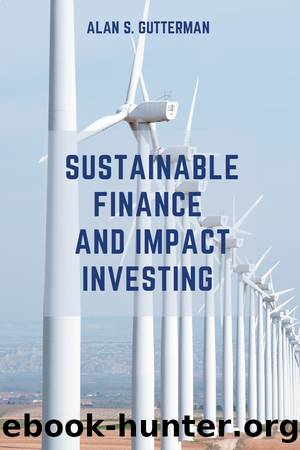Sustainable Finance and Impact Investing by Alan S. Gutterman

Author:Alan S. Gutterman [Alan S. Gutterman]
Language: eng
Format: epub
Publisher: Business Expert Press
Published: 2021-02-08T16:00:00+00:00
CHAPTER 4
Organizing for Impact Investment
In this chapter we consider various issues and actions to be taken in relation to designing and implementing an organizational framework for engaging in impact investing. As we have seen, there is a wide range of impact investors and each of them has their own unique set of investment and impact goals. In addition, institutions and other organizational forms which assume responsibility for investing the assets of others, such as foundations, endowments, and investment funds, have legal responsibilities as fiduciaries of the ultimate owners of the assets that are being invested. Each asset owner must address the fundamental questions raised in this chapter and establish a sufficient level of internal formality to build the team and other resources necessary to make good decisions about impact investing, even if those decisions are limited to the selection of intermediaries to actively manage the assets on a day-to-day basis. Intermediaries, such as fund managers, must also create an organizational framework for impact investing that can be explained to their prospective investors. This process will be illustrated later in the chapter when we discuss formation of impact investment funds. The opening sections generally assume that the organizational process is being carried out by a foundation.
Organizing should begin with visiting (or revisiting) a series of fundamental questions and issues relating to the investment and impact motivations and goals of the asset owner or fund manager.1 Simply put, this is the time to wrestle with the fundamental question of what is the owner or manager is looking to achieve by engaging in impact investing. A simple, yet comprehensive, framework for preparing to launch an impact investing programs recommended by Rockefeller Philanthropy Advisors (RPA) involves consideration of the following2:
⢠Why is the asset owner/manager interested in impact investing? Asset owners and fund managers may have several reasons for considering impact investing including a desire to have a social impact, an interest in integrating traditional investment focused on financial return with philanthropic activities, an interest in supporting the development of innovative technologies by social entrepreneurs looking to implement those technologies to address social problems, a belief that market forces can contribute to the pursuit of social good, an interest in using data and sophisticated data analysis to optimize potential impact, a belief that capital markets can expand the scope of impact beyond traditional philanthropic initiatives, and a recognition that impact investing can provide competitive financial returns.
⢠What type of changes is the asset owner/manager seeking to achieve through impact investing? Many investors begin with a list of broad categories such as poverty, health, climate change, and/or education, or look for opportunities to invest in funds, enterprises and projects that are focused on specific challenges (e.g., delivery of innovative educational technology), populations (e.g., women, children, elderly, people of color, or people with disabilities), locations (e.g., a specific neighborhood area) or institutions (e.g., advocacy organizations, hospitals, schools or charities). Another approach is to provide support for various parts of an ecosystem created for the development and deployment of innovative technologies to address a range of social problems.
Download
This site does not store any files on its server. We only index and link to content provided by other sites. Please contact the content providers to delete copyright contents if any and email us, we'll remove relevant links or contents immediately.
International Integration of the Brazilian Economy by Elias C. Grivoyannis(75124)
The Radium Girls by Kate Moore(11621)
Turbulence by E. J. Noyes(7702)
Nudge - Improving Decisions about Health, Wealth, and Happiness by Thaler Sunstein(7247)
The Black Swan by Nassim Nicholas Taleb(6770)
Rich Dad Poor Dad by Robert T. Kiyosaki(6182)
Pioneering Portfolio Management by David F. Swensen(6082)
Man-made Catastrophes and Risk Information Concealment by Dmitry Chernov & Didier Sornette(5652)
Zero to One by Peter Thiel(5494)
Secrecy World by Jake Bernstein(4389)
Millionaire: The Philanderer, Gambler, and Duelist Who Invented Modern Finance by Janet Gleeson(4101)
The Age of Surveillance Capitalism by Shoshana Zuboff(3990)
Skin in the Game by Nassim Nicholas Taleb(3971)
The Money Culture by Michael Lewis(3849)
Bullshit Jobs by David Graeber(3836)
Skin in the Game: Hidden Asymmetries in Daily Life by Nassim Nicholas Taleb(3726)
The Dhandho Investor by Mohnish Pabrai(3561)
The Wisdom of Finance by Mihir Desai(3526)
Blockchain Basics by Daniel Drescher(3331)
